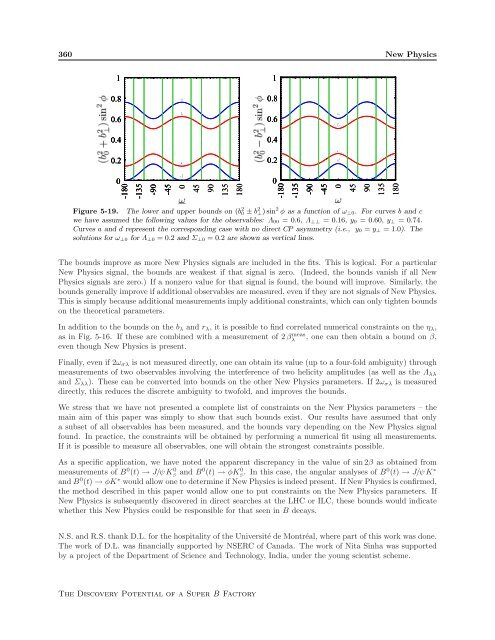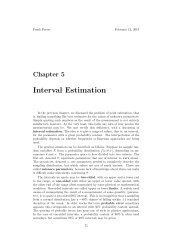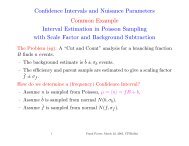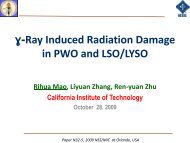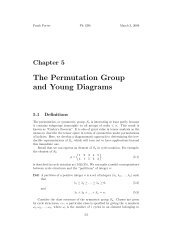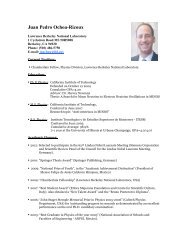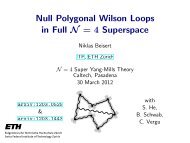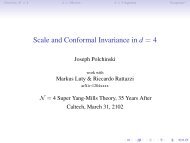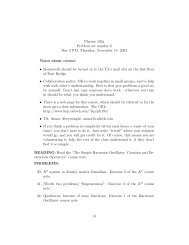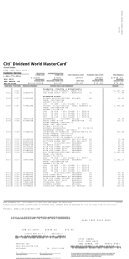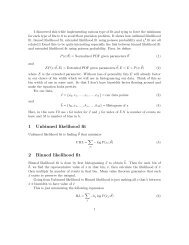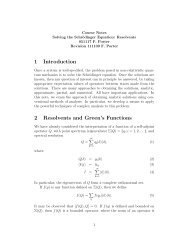- Page 3 and 4:
The Discovery Potential of a Super
- Page 5 and 6:
Contents 1 Introduction 1 1.1 Overv
- Page 7 and 8:
2.17.2 Transversity amplitudes . .
- Page 9 and 10:
Combined Strategies for γ . . . .
- Page 11 and 12:
Semileptonic tags . . . . . . . . .
- Page 13 and 14:
Signals of New Physics . . . . . .
- Page 15:
5.4.5 Warped Extra Dimensions Signa
- Page 18 and 19:
2 Introduction Current plans call f
- Page 20 and 21:
4 Introduction Several comments are
- Page 22 and 23:
6 Introduction Table 1-1. Measureme
- Page 24 and 25:
8 Introduction Table 1-4. Measureme
- Page 26 and 27:
10 Introduction Measuring γ Table
- Page 28 and 29:
12 Introduction Effective tagged sa
- Page 30 and 31:
14 Introduction 1.3 Conclusions As
- Page 32 and 33:
16 REFERENCES The Discovery Potenti
- Page 34 and 35:
18 Rare Decays 2.2 Present Status o
- Page 36 and 37:
20 Rare Decays B → ℓνℓγ, th
- Page 38 and 39:
22 Rare Decays corresponding to a p
- Page 40 and 41:
24 Rare Decays worked out. Updated
- Page 42 and 43:
26 Rare Decays the dilepton invaria
- Page 44 and 45:
28 Rare Decays 2.3 Theoretical tool
- Page 46 and 47:
30 Rare Decays to say that the resu
- Page 48 and 49:
32 Rare Decays analysis of the stab
- Page 50 and 51:
34 Rare Decays Table 2-3. Classific
- Page 52 and 53:
36 Rare Decays 2.5 Prospects for In
- Page 54 and 55:
38 Rare Decays however, that the co
- Page 56 and 57:
40 Rare Decays events. Measurements
- Page 58 and 59:
42 Rare Decays analyses [134, 51, 1
- Page 60 and 61:
44 Rare Decays a substantial portio
- Page 62 and 63:
46 Rare Decays As was analysed in [
- Page 64 and 65:
48 Rare Decays Efficiency ± π 1 0
- Page 66 and 67:
50 Rare Decays Total Error 0.1 0.08
- Page 68 and 69:
52 Rare Decays Table 2-8. Theoretic
- Page 70 and 71:
54 Rare Decays Η� Η� 1 0.8 0.
- Page 72 and 73:
56 Rare Decays 2.10 Prospects for m
- Page 74 and 75:
58 Rare Decays The hadronic paramet
- Page 76 and 77:
60 Rare Decays 2.12 Double Radiativ
- Page 78 and 79:
62 Rare Decays 2.13 Experimental As
- Page 80 and 81:
64 Rare Decays AFB AFB FBAsym Nent
- Page 82 and 83:
66 Rare Decays if one aims at a num
- Page 84 and 85:
68 Rare Decays Most of the comments
- Page 86 and 87:
70 Rare Decays A FB 1 0.5 0 −0.5
- Page 88 and 89:
72 Rare Decays Figure 2-14. The Dal
- Page 90 and 91:
74 Rare Decays mK ∗ EK ∗ A0(q 2
- Page 92 and 93:
76 Rare Decays 2.16.2 Sensitivity t
- Page 94 and 95:
78 Rare Decays 2.16.3 Electron vers
- Page 96 and 97:
80 Rare Decays 2.17 Angular distrib
- Page 98 and 99:
82 Rare Decays Р�РР� �
- Page 100 and 101:
84 Rare Decays Both asymmetries A (
- Page 102 and 103:
86 Rare Decays on ℓ = µ and assu
- Page 104 and 105:
88 Rare Decays 2.19 Experimental Pr
- Page 106 and 107:
90 Rare Decays 0.035 0.03 0.025 0.0
- Page 108 and 109:
92 Rare Decays • relatively good
- Page 110 and 111:
94 Rare Decays B(B → Xsνν) =(3.
- Page 112 and 113:
96 Rare Decays parametrizations wer
- Page 114 and 115:
98 Rare Decays 2.21 Purely Leptonic
- Page 116 and 117:
100 Rare Decays the scalar and pseu
- Page 118 and 119:
102 Rare Decays 2.22 Theoretical Pr
- Page 120 and 121:
104 Rare Decays spectrum starts to
- Page 122 and 123:
106 Rare Decays 2.23 B 0 → invisi
- Page 124 and 125:
108 Rare Decays Figure 2-33. From R
- Page 126 and 127:
110 Rare Decays data. Both this “
- Page 128 and 129:
112 Rare Decays 2.24.2 B → µµX
- Page 130 and 131:
114 Rare Decays 2.24.4 B → µµ T
- Page 132 and 133:
116 Rare Decays flavor-conserving o
- Page 134 and 135:
118 Rare Decays 2.26 Experimental P
- Page 136 and 137:
120 Rare Decays 2.27 Experimental A
- Page 138 and 139:
122 Rare Decays 2.28 Theoretical Pr
- Page 140 and 141:
124 Rare Decays and ˆs ≡ s/m 2 c
- Page 142 and 143:
126 Rare Decays Figure 2-39. The sa
- Page 144 and 145:
128 Rare Decays 2.28.2 Rare charm d
- Page 146 and 147:
130 Rare Decays [331] and B exp (D
- Page 148 and 149:
132 Rare Decays but the effects are
- Page 150 and 151:
134 Rare Decays • Rare radiative
- Page 152 and 153:
136 REFERENCES References [1] S. L.
- Page 154 and 155:
138 REFERENCES [59] Belle Collabora
- Page 156 and 157:
140 REFERENCES [117] G. P. Korchems
- Page 158 and 159:
142 REFERENCES [177] D. Melikhov an
- Page 160 and 161:
144 REFERENCES [234] See, for examp
- Page 162 and 163:
146 REFERENCES [288] A. Dedes, Mod.
- Page 164 and 165:
148 REFERENCES [346] BABAR Collabor
- Page 166 and 167:
150 REFERENCES The Discovery Potent
- Page 168 and 169:
152 Angles of the Unitarity Triangl
- Page 170 and 171:
154 Angles of the Unitarity Triangl
- Page 172 and 173:
156 Angles of the Unitarity Triangl
- Page 174 and 175:
158 Angles of the Unitarity Triangl
- Page 176 and 177:
160 Angles of the Unitarity Triangl
- Page 178 and 179:
162 Angles of the Unitarity Triangl
- Page 180 and 181:
164 Angles of the Unitarity Triangl
- Page 182 and 183:
166 Angles of the Unitarity Triangl
- Page 184 and 185:
168 Angles of the Unitarity Triangl
- Page 186 and 187:
170 Angles of the Unitarity Triangl
- Page 188 and 189:
172 Angles of the Unitarity Triangl
- Page 190 and 191:
174 Angles of the Unitarity Triangl
- Page 192 and 193:
176 Angles of the Unitarity Triangl
- Page 194 and 195:
178 Angles of the Unitarity Triangl
- Page 196 and 197:
180 Angles of the Unitarity Triangl
- Page 198 and 199:
182 Angles of the Unitarity Triangl
- Page 200 and 201:
184 Angles of the Unitarity Triangl
- Page 202 and 203:
186 Angles of the Unitarity Triangl
- Page 204 and 205:
188 Angles of the Unitarity Triangl
- Page 206 and 207:
190 Angles of the Unitarity Triangl
- Page 208 and 209:
192 Angles of the Unitarity Triangl
- Page 210 and 211:
194 Angles of the Unitarity Triangl
- Page 212 and 213:
196 Angles of the Unitarity Triangl
- Page 214 and 215:
198 Angles of the Unitarity Triangl
- Page 216 and 217:
200 Angles of the Unitarity Triangl
- Page 218 and 219:
202 Angles of the Unitarity Triangl
- Page 220 and 221:
204 Angles of the Unitarity Triangl
- Page 222 and 223:
206 Angles of the Unitarity Triangl
- Page 224 and 225:
208 Angles of the Unitarity Triangl
- Page 226 and 227:
210 Angles of the Unitarity Triangl
- Page 228 and 229:
212 Angles of the Unitarity Triangl
- Page 230 and 231:
214 Angles of the Unitarity Triangl
- Page 232 and 233:
216 Angles of the Unitarity Triangl
- Page 234 and 235:
218 Angles of the Unitarity Triangl
- Page 236 and 237:
220 Angles of the Unitarity Triangl
- Page 238 and 239:
222 Angles of the Unitarity Triangl
- Page 240 and 241:
224 Angles of the Unitarity Triangl
- Page 242 and 243:
226 Angles of the Unitarity Triangl
- Page 244 and 245:
228 Angles of the Unitarity Triangl
- Page 246 and 247:
230 Angles of the Unitarity Triangl
- Page 248 and 249:
232 Angles of the Unitarity Triangl
- Page 250 and 251:
234 Angles of the Unitarity Triangl
- Page 252 and 253:
236 Angles of the Unitarity Triangl
- Page 254 and 255:
238 Angles of the Unitarity Triangl
- Page 256 and 257:
240 Angles of the Unitarity Triangl
- Page 258 and 259:
242 Angles of the Unitarity Triangl
- Page 260 and 261:
244 REFERENCES [27] M. Grothe, Mod.
- Page 262 and 263:
246 REFERENCES [84] A. F. Falk et a
- Page 264 and 265:
248 REFERENCES [139] Belle Collabor
- Page 266 and 267:
250 REFERENCES [188] W. Bernreuther
- Page 268 and 269:
252 Semileptonic Decays and Sides o
- Page 270 and 271:
254 Semileptonic Decays and Sides o
- Page 272 and 273:
256 Semileptonic Decays and Sides o
- Page 274 and 275:
258 Semileptonic Decays and Sides o
- Page 276 and 277:
260 Semileptonic Decays and Sides o
- Page 278 and 279:
262 Semileptonic Decays and Sides o
- Page 280 and 281:
264 Semileptonic Decays and Sides o
- Page 282 and 283:
266 Semileptonic Decays and Sides o
- Page 284 and 285:
268 Semileptonic Decays and Sides o
- Page 286 and 287:
270 Semileptonic Decays and Sides o
- Page 288 and 289:
272 Semileptonic Decays and Sides o
- Page 290 and 291:
274 Semileptonic Decays and Sides o
- Page 292 and 293:
276 Semileptonic Decays and Sides o
- Page 294 and 295:
278 Semileptonic Decays and Sides o
- Page 296 and 297:
280 Semileptonic Decays and Sides o
- Page 298 and 299:
282 Semileptonic Decays and Sides o
- Page 300 and 301:
284 Semileptonic Decays and Sides o
- Page 302 and 303:
286 Semileptonic Decays and Sides o
- Page 304 and 305:
288 Semileptonic Decays and Sides o
- Page 306 and 307:
290 Semileptonic Decays and Sides o
- Page 308 and 309:
292 Semileptonic Decays and Sides o
- Page 310 and 311:
294 Semileptonic Decays and Sides o
- Page 312 and 313:
296 Semileptonic Decays and Sides o
- Page 314 and 315:
298 Semileptonic Decays and Sides o
- Page 316 and 317:
300 Semileptonic Decays and Sides o
- Page 318 and 319:
302 Semileptonic Decays and Sides o
- Page 320 and 321:
304 Semileptonic Decays and Sides o
- Page 322 and 323:
306 Semileptonic Decays and Sides o
- Page 324 and 325:
308 Semileptonic Decays and Sides o
- Page 326 and 327: 310 Semileptonic Decays and Sides o
- Page 328 and 329: 312 Semileptonic Decays and Sides o
- Page 330 and 331: 314 REFERENCES [25] N. Isgur, M. Wi
- Page 332 and 333: 316 REFERENCES [66] A. K. Leibovich
- Page 334 and 335: 318 REFERENCES [122] P. Ball and V.
- Page 336 and 337: 320 REFERENCES [182] A. I. Sanda an
- Page 338 and 339: 322 New Physics Physics and measure
- Page 340 and 341: 324 New Physics 5.2 Model-independe
- Page 342 and 343: 326 New Physics Rather promising, h
- Page 344 and 345: 328 New Physics For the Standard Mo
- Page 346 and 347: 330 New Physics Figure 5-2. Results
- Page 348 and 349: 332 New Physics These new parameter
- Page 350 and 351: 334 New Physics Figure 5-5. Results
- Page 352 and 353: 336 New Physics Figure 5-7. Results
- Page 354 and 355: 338 New Physics Figure 5-10. Result
- Page 356 and 357: 340 New Physics O9 = e2 g 2 s sαγ
- Page 358 and 359: 342 New Physics the Standard Model
- Page 360 and 361: 344 New Physics For muons we identi
- Page 362 and 363: 346 New Physics � 10 5 0 -5 -10 -
- Page 364 and 365: 348 New Physics In all cases, the w
- Page 366 and 367: 350 New Physics The key point is th
- Page 368 and 369: 352 New Physics which allows us to
- Page 370 and 371: 354 New Physics Extremizing this ex
- Page 372 and 373: 356 New Physics 0.8 0.7 0.6 0.5 0.4
- Page 374 and 375: 358 New Physics 12 10 8 6 4 2 0 -2
- Page 378 and 379: 362 New Physics g bR (L) δ m sL (R
- Page 380 and 381: 364 New Physics • maximal-parity:
- Page 382 and 383: 366 New Physics SΦKs 1 0.75 0.5 0.
- Page 384 and 385: 368 New Physics b s s (s b) V-A (s
- Page 386 and 387: 370 New Physics could increase f⊥
- Page 388 and 389: 372 New Physics The ratio of transv
- Page 390 and 391: 374 New Physics where ψ is the cc
- Page 392 and 393: 376 New Physics Since, a(s)eiδa(s)
- Page 394 and 395: 378 New Physics b B 0 ~ b A d �
- Page 396 and 397: 380 New Physics Table 5-5. Measured
- Page 398 and 399: 382 New Physics One of the strategi
- Page 400 and 401: 384 New Physics Table 5-10. 99% CL
- Page 402 and 403: 386 New Physics This is simply the
- Page 404 and 405: 388 New Physics scale, the insertio
- Page 406 and 407: 390 New Physics In the first model,
- Page 408 and 409: 392 New Physics ∆m( B s ) / ∆m(
- Page 410 and 411: 394 New Physics Table 5-12. Pattern
- Page 412 and 413: 396 New Physics such cases. We shou
- Page 414 and 415: 398 New Physics where (m2 dL(R) ˜
- Page 416 and 417: 400 New Physics ×Ä �×Ä �
- Page 418 and 419: 402 New Physics Table 5-14. Bounds
- Page 420 and 421: 404 New Physics Figure 5-35. Allowe
- Page 422 and 423: 406 New Physics Conclusions We have
- Page 424 and 425: 408 New Physics CP violation from
- Page 426 and 427:
410 New Physics are basically affec
- Page 428 and 429:
412 New Physics remain close to the
- Page 430 and 431:
414 New Physics + 4 s2 C2 7(1 − s
- Page 432 and 433:
416 New Physics Quarks Leptons thic
- Page 434 and 435:
418 New Physics Yukawa matrices (ea
- Page 436 and 437:
420 New Physics The effects of the
- Page 438 and 439:
422 New Physics functions of 1/R fo
- Page 440 and 441:
424 New Physics normalized AFB 0.15
- Page 442 and 443:
426 New Physics In addition, the lo
- Page 444 and 445:
428 New Physics From Eq. (5.9) we c
- Page 446 and 447:
430 New Physics There will also be
- Page 448 and 449:
432 New Physics gauge KK modes to z
- Page 450 and 451:
434 New Physics 5.5 Lepton Flavor V
- Page 452 and 453:
436 New Physics observation of τ
- Page 454 and 455:
438 New Physics LFV τ decays in th
- Page 456 and 457:
440 New Physics over these processe
- Page 458 and 459:
442 New Physics � � Ï Applicat
- Page 460 and 461:
444 New Physics Table 5-22. Experim
- Page 462 and 463:
446 New Physics Table 5-23. Pattern
- Page 464 and 465:
448 REFERENCES [26] Belle Collabora
- Page 466 and 467:
450 REFERENCES [78] A. J. Buras et
- Page 468 and 469:
452 REFERENCES [131] M. Beneke et a
- Page 470 and 471:
454 REFERENCES [175] R. Harnik et a
- Page 472 and 473:
456 REFERENCES [227] J. L. Hewett,
- Page 474 and 475:
458 REFERENCES [272] H. Davoudiasl,
- Page 476 and 477:
460 REFERENCES [316] K. Tobe, J. D.
- Page 478 and 479:
462 REFERENCES The Discovery Potent
- Page 480 and 481:
464 Workshop Participants Stefan Ch
- Page 482 and 483:
466 Workshop Participants David Lei
- Page 484:
468 Workshop Participants Abner Sof


